Spring is gradually coming around again. So now is the perfect time to prepare for the planting season. It will be wonderful to get some soil under your fingernails and get a little closer to nature. Do you have a garden and do you want to fill its various borders with the most beautiful flower bulbs and garden plants? If so, it is useful to make a plan now. Here are some tips to help you with the construction and filling of your garden borders.
How do you create a border?
Creating a border is a fun and exciting challenge. And, you don't always need a garden designer! First, choose the style that suits your garden. For example, do you want tall, stone borders or do you prefer natural borders? Then you can already mark the borders by laying a layer of boulders, wood or other natural material. It is also easy to create your own borders with Bakker's border edges. You just have to determine the dimensions and fit the edges into the soil. It makes a super quick and easy home-made border, completely ready for spring.
What will you plant in the spring?
It is useful to make a garden plan before you actually get started in the garden. Find out how to create a garden plan here. For a border, take into account specific elements like flowering periods and your budget. Many plants and flowers only bloom for a few months. You can choose to arrange plants or bulbs that bloom one after the other for a long-lasting result, or to have them bloom at the same time for a large explosion of colour. With Bakker's handy, ready-to-use border packages, you don't have to think about these things yourself.
Of course, it is also possible to combine all kinds of greenery yourself. It is then very important to take colour into account. To optimally enjoy your border, it is advisable to think carefully in advance about the colours you want to see. Some combinations have a fantastic effect, while with other mixes, colour can disappear. Have a look at this list of colour pallets, put together with you in mind:
- Bright colours: do you want a border with bright colours? Then use a lot of primary colours. For a calmer border, mix primary colours with secondary colours, such as green. Be careful with dominant colours such as red, which can dominate if you also choose other colours.
- Pastel colours: Pastel colours give a soft and lovely atmosphere in the garden. Make sure that you have different pastel colours in your border, otherwise the border will be a bit pale.
- Dark colours: Mix plants and flowers of a dark colour (such as dark blue and dark green) with lighter colours such as white, silvery grey, yellow or orange. That way, plants with dark colours will stand out better. Too much dark colour results in a border with less impact.
- Warm colours: For a border with warm colours, it is best to use mainly red, orange and yellow tones. The border will really radiate in the summer.
- Soft colours: For a cool or softer border, choose more neutral colours such as white, pink and blue. These colours have less impact than, for instance, red and purple.
Tip: Bear in mind that light also affects colour. In sunny weather, some flowers will show better than they will under overcast skies.
If you do not know what to plant this spring, get inspired by Bakker's blogs on flower bulbs and garden plants.
Light affects colours. Dark flowers need a lot of light to achieve their full potential. White flowers look better on a cloudy day, in the shade or at dusk.
Get started
As soon as the border has been laid out, you can start with the most fun part… planting! There are also a number of things to take into account when planting. For example, give your sunny spots to the plants and flowers that like full sun. Give very sensitive flowers a place out of the wind where they will not be blown over.
When planting, it is always advisable to get started with preparing the soil first. Make sure that the weeds have been removed and the soil is well-turned. To improve the quality of the soil, mix it with fresh potting soil. Pay close attention to the needs of your plants. One plant may prefer acidic soils, while another will prefer a clay soils. You can always read about this on the plant label on the packaging and on Bakker's website. And then the time has finally come, you can start planting. Always dig large holes for the roots or bulbs, fill the holes with fresh potting compost and press the soil down lightly. Do not forget to give some extra water after planting.
Do you want to make a start with your borders? Then check Bakker's extensive garden range in the online shop.




